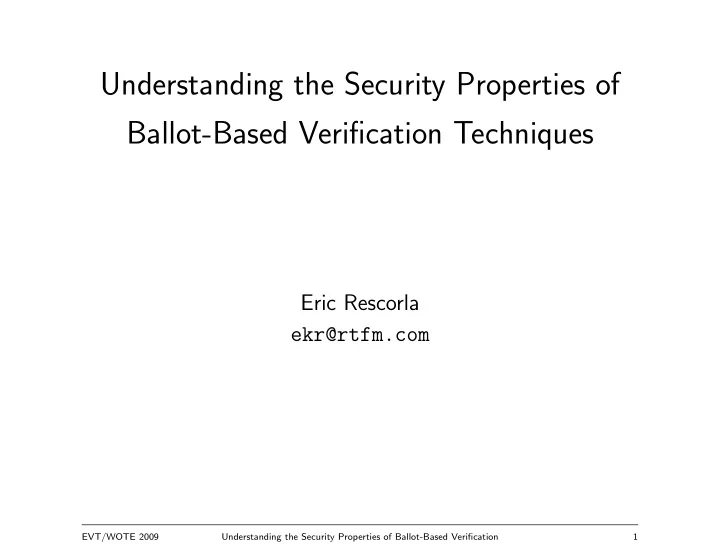

Understanding the Security Properties of Ballot-Based Verification Techniques Eric Rescorla ekr@rtfm.com EVT/WOTE 2009 Understanding the Security Properties of Ballot-Based Verification 1
WARNING This talk contains no research content. EVT/WOTE 2009 Understanding the Security Properties of Ballot-Based Verification 2
Two views of vote tabulation Official Official EMS Scanner(s) Tally Returned Ballots The insider’s view Official Opaque Process Tally Returned Ballots The outsider’s view EVT/WOTE 2009 Understanding the Security Properties of Ballot-Based Verification 3
What are we trying to verify? • The votes were correctly counted • The right candidate won • The stack of votes in front of us was correctly counted • A recount of this stack of votes wouldn’t change the winner • Third party verifiability: A third party with no special access can verify that a recount of this stack* of votes wouldn’t change the winner * Alert: we are sweeping the topic of ballot chain of custody under the rug. EVT/WOTE 2009 Understanding the Security Properties of Ballot-Based Verification 4
Why ballot-based audits? • Statistical power of an audit depends on the number of samples – Very little dependency on the size of each sample – (Assuming attacker is intelligent) • Traditional precinct-based audits are not very efficient • Auditing individual ballots is far more efficient • Independently proposed several times [CHF07, Nef03, Joh04] EVT/WOTE 2009 Understanding the Security Properties of Ballot-Based Verification 5
Ballot-Based Auditing Workflow [CHF07] Ballot Scanner Images/ EMS CVRs Returned Ballots Official Counting Process Audit Process Election Verify Audit Sampled Results Tabulation Ballots Observer Scanned Ballots Adapted from [SRW09] EVT/WOTE 2009 Understanding the Security Properties of Ballot-Based Verification 6
Problems with Ballot-Based Auditing • Finding individual ballots is hard – Possibilities: serial numbers on ballots, hand-indexing, paper counters, weight... • We need to publish the contents of each ballot (CVR or image) – Accessible to any third party – The ballots are anonymous but all contents are published – This allows coercion and vote buying ∗ Easiest if we publish images ∗ Pattern voting EVT/WOTE 2009 Understanding the Security Properties of Ballot-Based Verification 7
What about ballot images? • Trivial to encode information • Even valid marks can encode information – Incompletely/overfilled • Could digitally sanitize – You’ve just turned ballots into CVRs EVT/WOTE 2009 Understanding the Security Properties of Ballot-Based Verification 8
The Math of Pattern Voting • Basic idea: encode voter identity in downticket races – Assume results are reported by precinct ∗ Just need to identify voter within precincts – Need to encode no more than 1000-10,000 distinct identities (10-14 bits) • Each contest lets us encode minimum 1-2 bits – Alice, Bob, undervote, overvote(?) – 10 contests is enough to encode 60,000–1,000,000 identies EVT/WOTE 2009 Understanding the Security Properties of Ballot-Based Verification 9
Humboldt Election Transparency Project Workflow Official Official EMS Scanner Tally Returned Ballots Official Counting Process ETP Rescanning Process Signed ETP ETP Imprinter Ballot Scanner Computer Images Scanned Ballots EVT/WOTE 2009 Understanding the Security Properties of Ballot-Based Verification 10
Advantages of ETP Style Approaches • Fast detection of scanner/EMS errors – Requires minimal manual intervention – It already has found errors: Deck 0 bug – Independent check on compromise of EMS (or scanner) by outsiders • Backup for physical control of ballots – Only applies post-scanning – And requires tight control of images or signing key EVT/WOTE 2009 Understanding the Security Properties of Ballot-Based Verification 11
Does the ETP offer third party verifiability? • Third parties can independently count the scanned ballots – With BallotBrowser or their own software • This only detects some errors – Third parties cannot verify the ETP scanner software – What if it substitutes fake ballot images? – This cannot be detected by re-processing those images • Checking the images requires random sampling – ... At the same level as a ballot-based audit • Easiest to think of ETP checking the tabulation EVT/WOTE 2009 Understanding the Security Properties of Ballot-Based Verification 12
Why digital signatures don’t help • Signatures are applied by the ETP scanning computer [Tra08] • Third parties can download ballot images – And verify that they weren’t tampered in transit • But this doesn’t help if the ETP scanner is compromised – You’re getting fake ballot images that weren’t tampered in transit • Signatures are sort of overkill here – Could just publish a message digest in a non-tamperable form (e.g., local paper) EVT/WOTE 2009 Understanding the Security Properties of Ballot-Based Verification 13
Summary • Ballot-based auditing systems have far higher statistical power – But worse privacy properties (vote buying and coercion) • Finding the right physical ballot is a challenge • ETP provides good detection of scanner/EMS error – And some kinds of outsider attack • ... But requires a separate audit for third-party verifiability EVT/WOTE 2009 Understanding the Security Properties of Ballot-Based Verification 14
References [CHF07] Joseph A. Calandrino, J. Alex Halderman, and Edward W. Felten. Machine-assisted election auditing. USENIX/ACCURATE Electronic Voting Technology Workshop 2007, August 2007. http://www.usenix.org/events/evt07/tech/full_papers/ calandrino/calandrino.pdf . [Joh04] Kenneth C. Johnson. Election certification by statistical audit of voter-verified paper ballots, October 2004. http://papers.ssrn.com/sol3/papers.cfm?abstract_id=640943 . [Nef03] C. Andrew Neff. Election confidence—a comparison of methodologies and their relative effectiveness at achieving it (revision 6), December 2003. http://web.archive.org/web/20060117190359/http: //www.votehere.net/papers/ElectionConfidence.pdf . [SRW09] Cynthia Sturton, Eric Rescorla, and David Wagner. Weight, Weight, Don’t Tell Me: Using Scales to Select Ballots for Auditing. In Joseph Lorenzo Hall, David Jefferson, and Tal Moran, editors, Proceedings of EVT/WOTE 2009. USENIX/ACCURATE/IAVoSS, August 2009. To appear. [Tra08] Mitch Trachtenberg. Can’t Digital Images Be Faked. http://democracycounts. blogspot.com/2008/07/cant-digital-images-be-faked.html , August 2008. EVT/WOTE 2009 Understanding the Security Properties of Ballot-Based Verification 15
Recommend
More recommend